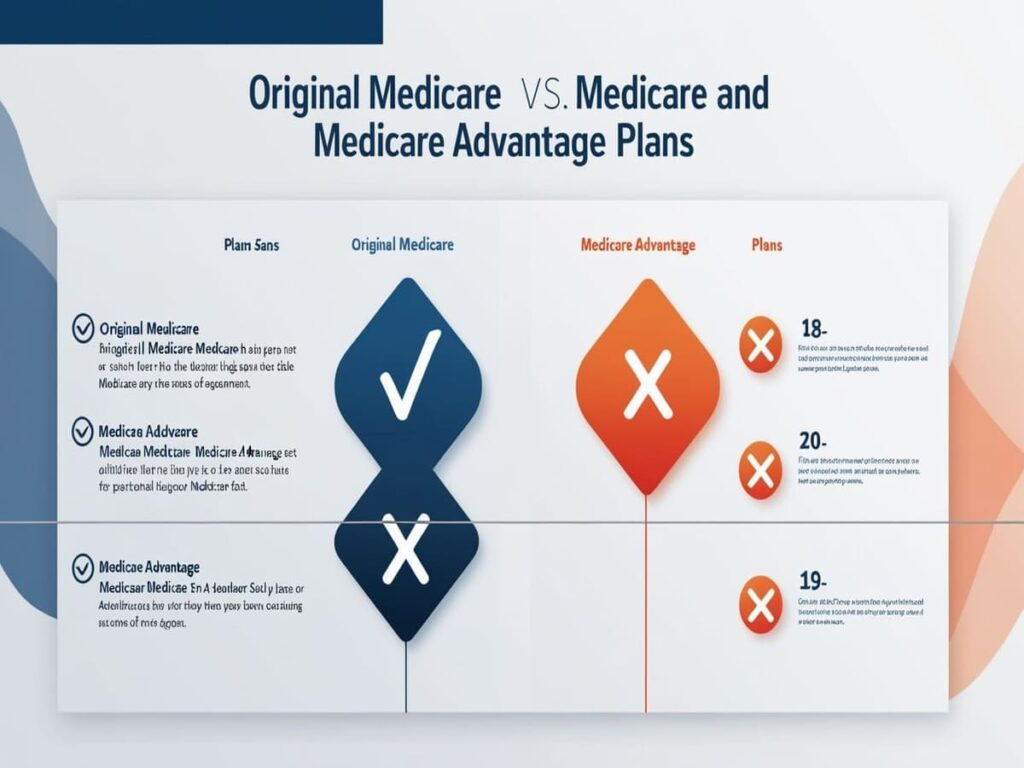Introduction to Medicare in the USA
What Is Medicare?
Medicare is a national health insurance program in the United States designed primarily for individuals aged 65 and older. But it doesn’t stop there—people under 65 with certain disabilities or conditions like End-Stage Renal Disease (ESRD) can also qualify. Unlike private insurance, Medicare is run by the federal government and funded by payroll taxes, premiums, and general revenue.
Think of Medicare as a safety net. It steps in when private insurance stops or isn’t available, offering peace of mind to millions of Americans. Whether you’re retiring soon, living with a disability, or helping a loved one navigate their coverage, Medicare plays a vital role in ensuring access to essential medical services—from routine doctor visits to life-saving hospital care.
It’s not a one-size-fits-all program, though. It has multiple parts, each designed to cover specific healthcare services. That’s why understanding how Medicare works isn’t just smart—it’s essential for making the right healthcare choices, especially as you get older or manage complex medical needs.
Brief History and Purpose of Medicare
Medicare was signed into law in 1965 by President Lyndon B. Johnson, alongside Medicaid, to ensure elderly and low-income individuals weren’t left out of essential healthcare. Before Medicare, over half of Americans over 65 had no health insurance. Now, more than 60 million people depend on it.
The core goal? To make healthcare accessible and affordable for older Americans and those with long-term disabilities. Over time, it has evolved to include prescription drug coverage (Part D), Medicare Advantage plans (Part C), and preventive services. Its impact is massive—keeping hospital doors open for seniors, providing critical drug access, and helping manage chronic diseases.

In 2025, Medicare continues to evolve, adding benefits and adapting to the needs of a changing population. Whether you’re planning ahead or already enrolled, understanding Medicare’s foundation gives you the tools to navigate its complexities.
👉 Looking to explore all the available Medicare coverage options straight from the official source? Don’t miss our detailed breakdown in Go Medicare Gov Medicare Coverage Options, where we walk you through what’s offered, how to compare plans, and tips to navigate Medicare.gov with ease.
Who Is Eligible for Medicare?
Age-Based Eligibility
If you’ve hit that magic number—65—you’re generally eligible for Medicare. The process usually starts automatically if you’re already receiving Social Security or Railroad Retirement benefits. If not, you can apply three months before your 65th birthday.
But it’s not just about your age. You must also be a U.S. citizen or a legal resident who’s lived in the country for at least five continuous years. Timing matters too: missing your initial enrollment window can lead to penalties, so it’s critical to know the key dates.
It’s also worth noting that some people qualify earlier, and that’s where things get interesting…
Disability and Medical Conditions
If you’re under 65 and have been receiving Social Security Disability Insurance (SSDI) for at least 24 months, you’ll automatically be enrolled in Medicare. Some conditions fast-track your eligibility, such as:
- End-Stage Renal Disease (ESRD) – requiring regular dialysis or a kidney transplant.
- Amyotrophic Lateral Sclerosis (ALS) – also known as Lou Gehrig’s disease; eligibility starts the same month your disability benefits begin.
These provisions ensure that those with severe and costly medical needs aren’t left to fend for themselves. Medicare becomes a lifeline, providing structured access to treatments, medications, and specialist care.
Enrollment Periods You Should Know
Timing is everything when it comes to Medicare enrollment. Here are the windows you need to know:
- Initial Enrollment Period (IEP): Starts 3 months before your 65th birthday, includes your birthday month, and ends 3 months after.
- General Enrollment Period (GEP): Jan 1 – Mar 31 each year for those who missed IEP.
- Special Enrollment Periods (SEP): Triggered by life events like losing employer coverage.
Missing these windows can cost you—not just in stress, but in late penalties that stick around for life. Be proactive, mark your calendar, and get enrolled on time to avoid extra costs.
Different Parts of Medicare Explained
Medicare Part A (Hospital Insurance)
Medicare Part A is often referred to as “hospital insurance” because it primarily covers inpatient services. Think hospital stays, skilled nursing facility care, hospice, and even some home health services.
Here’s the good news: If you’ve paid into Medicare through payroll taxes for at least 10 years (40 quarters), you likely won’t have to pay a monthly premium for Part A. But don’t get too comfortable—there are still deductibles and co-insurance costs to consider.
Let’s break it down:
- Inpatient hospital care: Covers semi-private rooms, meals, nursing, and related services.
- Skilled nursing care: After a qualifying hospital stay, you can get coverage for up to 100 days.
- Hospice care: If you have a terminal illness, Part A covers hospice services.
- Home health services: Intermittent skilled nursing care and therapy may be covered.
But beware: Part A doesn’t cover long-term custodial care or private rooms unless medically necessary. Many people assume Medicare pays for extended nursing home stays—it doesn’t.
Understanding these limits helps you prepare for out-of-pocket costs or decide whether supplemental coverage is right for you.

Medicare Part B (Medical Insurance)
While Part A handles the hospital side, Medicare Part B takes care of the outpatient world. Doctor visits, preventive care, lab work, mental health services, durable medical equipment—this is where Part B steps in.
Everyone pays a premium for Part B, and it’s adjusted based on your income. In 2025, the standard monthly premium is around $174.70, but if you’re a higher earner, expect to pay more.
Here’s a closer look at what’s covered:
- Doctor’s office visits
- Outpatient care
- Diagnostic tests (like X-rays, MRIs)
- Vaccinations (flu, COVID-19, pneumonia)
- Mental health services
- Annual wellness visit
There’s a $240 annual deductible (for 2025), after which Medicare pays 80% of the approved amount, and you’re responsible for the remaining 20%. No out-of-pocket limit means those 20% costs can stack up if you’re not careful.
Many people combine Part B with a Medigap or Advantage plan to help cover what’s not included. If you’re planning surgeries, therapies, or ongoing treatments, understanding Part B is critical.
Medicare Part C (Medicare Advantage)
Medicare Part C, also known as Medicare Advantage, is where things get a bit more flexible—and complicated. This option is an alternative to Original Medicare (Parts A and B), provided through private insurance companies approved by Medicare. When you enroll in Part C, you’re still in Medicare, but your benefits come from a private insurer.
So why do millions choose Medicare Advantage? Because it often bundles hospital, medical, and even drug coverage into one single plan. Many plans also offer extra perks like:
- Dental and vision care
- Hearing aids
- Gym memberships (SilverSneakers)
- Transportation to appointments
- Over-the-counter allowances
These added benefits can be a game changer for seniors on a budget. But there are trade-offs. Medicare Advantage plans often require you to use a network of doctors and hospitals, and you may need referrals to see specialists.
Another thing to consider: costs can vary. While some plans have $0 premiums, you might pay more in co-pays or deductibles, especially if you need specialized or out-of-network care.
Bottom line? If you’re healthy and want all-in-one coverage with extra perks, Medicare Advantage could be a great fit. But if you see multiple doctors or prefer flexibility, Original Medicare with a Medigap plan might be better.
Medicare Part D (Prescription Drug Coverage)
Prescription drug costs can break the bank—especially for seniors managing chronic conditions. That’s where Medicare Part D steps in. It provides coverage for prescription medications and is available through private insurance companies either as a stand-alone plan or bundled with Medicare Advantage.
Part D plans vary by insurer, but they all follow a similar structure:
- Monthly Premium – Varies by plan.
- Annual Deductible – Some plans waive this; others may charge up to a limit ($545 in 2025).
- Initial Coverage – You pay a portion, and your plan pays the rest.
- Coverage Gap (“Donut Hole”) – After spending a certain amount, you pay a larger share.
- Catastrophic Coverage – After hitting the out-of-pocket threshold, you pay a minimal co-payment.
Common medications can cost pennies with Part D, while brand-name drugs could still be pricey. That’s why reviewing your plan every year during the Annual Enrollment Period (Oct 15 – Dec 7) is crucial—formularies and pricing change frequently.
Helpful tip: Use Medicare’s Plan Finder Tool to compare plans based on the meds you take. It could save you hundreds annually.
How to Enroll in Medicare
Step-by-Step Enrollment Process
Enrolling in Medicare might sound complicated, but it’s easier when you know the steps:
- Determine Your Eligibility – Are you turning 65? Have a qualifying disability?
- Know Your Enrollment Window – Most people start during their Initial Enrollment Period (3 months before and after your 65th birthday).
- Sign Up for Original Medicare (A & B) – You can enroll through the Social Security Administration (SSA).
- Decide on Additional Coverage – Do you want a Medigap plan or a Medicare Advantage Plan? Will you need Part D?
- Use the Right Platforms – You can sign up online, by phone, or at your local Social Security office.
Once enrolled, your Medicare card will arrive by mail. From there, it’s all about choosing the right plan combinations for your health and budget.
Online vs. In-Person Enrollment Options
The digital age has made signing up for Medicare smoother than ever. You can now enroll online through SSA.gov in less than 15 minutes. It’s safe, secure, and available 24/7.
Prefer face-to-face help? No problem. Visit your local Social Security office or call 1-800-MEDICARE to speak with an agent. Many states also offer free counseling through SHIP (State Health Insurance Assistance Programs).
No matter how you enroll, make sure you:
- Have your Social Security number
- Provide proof of age and citizenship/residency
- Understand your choices before signing up
👉 If you’re a Florida resident considering Medicare Advantage, you’ll want to check out our expert roundup of the Best Medicare Advantage Plans in Florida. We compare the top-rated plans, coverage details, and benefits specific to the Sunshine State.
What Does Medicare Cover?
Inpatient vs. Outpatient Services
One of the biggest sources of confusion in Medicare? What’s actually covered. Let’s clear it up.
Inpatient care, covered by Part A, refers to hospital stays and treatments that require an overnight stay. This includes:
- Semi-private rooms
- Nursing services
- Meals
- Medications during hospital stay
- Some mental health care
On the flip side, outpatient care—under Part B—involves services where you don’t stay overnight:
- Emergency room visits
- Doctor checkups
- Diagnostic tests
- Physical therapy
- Mental health outpatient care
Why does this matter? Because Medicare handles billing and cost-sharing differently depending on the setting. You might pay a deductible and daily co-pays for inpatient services, while outpatient care involves a 20% coinsurance after meeting your Part B deductible.
Understanding this split helps you budget better and avoid surprise bills, especially when dealing with planned surgeries or emergency visits.
Preventive Care and Wellness Services
Medicare isn’t just for when you’re sick. It also helps you stay well. Preventive services are one of the best benefits of being on Medicare—most of them are free if your provider accepts Medicare.
Here’s what’s included:
- Annual wellness visit
- Flu and COVID-19 vaccines
- Mammograms
- Colorectal cancer screenings
- Diabetes screenings
- Bone mass measurements
Catching health issues early can save lives—and money. Be proactive. Schedule your free screenings and check-ups, and talk to your doctor about what’s available to you under Medicare.
Prescription Medications and Equipment
We already covered Part D, but here’s the big picture: Medicare helps with many kinds of health-related products and prescriptions.
Medicare Part B covers:
- Durable Medical Equipment (DME) like walkers, wheelchairs, and oxygen
- Certain medications administered in a doctor’s office
- Diabetic supplies (test strips, monitors)
Meanwhile, Part D helps cover:
- Retail prescription drugs
- Some vaccines
- Insulin and related supplies (starting 2023, insulin costs are capped at $35/month)
Understanding what’s covered under each part is crucial. It can help you avoid paying out-of-pocket for things Medicare might already be handling—if you know where to look.
Medicare Costs and Premiums
Understanding Deductibles, Copayments, and Coinsurance
Medicare isn’t free—and knowing how the costs break down can prevent some major financial headaches. There are three key terms you need to master:
- Deductible: What you pay before Medicare starts paying.
- Copayment: A fixed amount for a service (like $20 for a doctor’s visit).
- Coinsurance: A percentage of the cost you pay (often 20%).
Here’s a simple example:
If you go to a doctor and the bill is $200, after your Part B deductible, Medicare covers 80% ($160), and you pay 20% ($40).
Now multiply that by multiple visits, specialist consultations, or ongoing treatments—and you can see how these “small” costs add up.
Premiums for Each Medicare Part
Here’s what most people pay in 2025:
- Part A: Usually free if you’ve worked 10+ years.
- Part B: $174.70/month (higher for high-income earners).
- Part C (Advantage): Varies by plan, many are $0 premium.
- Part D: Average is $34/month, but it varies.
And don’t forget about IRMAA (Income-Related Monthly Adjustment Amount). If your income is above a certain threshold, you’ll pay more for Parts B and D.
Financial Assistance Programs
Struggling with costs? Medicare has your back. Several programs can help reduce premiums and out-of-pocket costs:
- Medicare Savings Programs (MSPs)
- Extra Help (for Part D)
- Medicaid (dual-eligible)
- PACE (for low-income seniors needing long-term care)
These programs can be life-changing—offering full or partial assistance with premiums, copays, and even prescription costs.
Medicare Advantage vs Original Medicare
Key Differences Between the Two
Choosing between Original Medicare and Medicare Advantage (Part C) can feel like comparing apples and oranges. Both offer essential healthcare coverage, but they do so in very different ways.
Original Medicare is the traditional government-run program. It includes:
- Part A: Hospital Insurance
- Part B: Medical Insurance
With Original Medicare, you can see any doctor or hospital that accepts Medicare—no networks, no referrals. You also have the option to add a Medigap (supplemental) plan to cover what Medicare doesn’t, and a Part D plan for prescription drugs.
On the other hand, Medicare Advantage is run by private insurers and combines your Part A and B into one plan. Most Advantage plans also include:
- Prescription drug coverage
- Extra benefits like dental, vision, hearing, gym memberships, and more
But there’s a catch—you often need to stick to a provider network and may need a referral to see a specialist.
Pros and Cons of Each Option
Here’s a quick side-by-side comparison:
| Feature | Original Medicare | Medicare Advantage |
|---|---|---|
| Provider Flexibility | Any Medicare-accepting provider | Limited to plan’s network |
| Referral Requirement | No | Usually required |
| Prescription Coverage | Separate Part D plan needed | Often included |
| Extra Benefits | Not included | Often includes vision, dental |
| Out-of-Pocket Limit | None | Yes, annual maximum |
| Nationwide Coverage | Yes | Sometimes limited to regions |
Original Medicare gives you freedom and flexibility, ideal if you travel often or have multiple providers. But it doesn’t cap your annual spending unless you get a Medigap plan.
Medicare Advantage may save you money up front and includes more perks—but you’ll have to follow more rules and stay in-network.
How to Choose What’s Right for You
It boils down to your personal needs:
- Do you travel a lot? Go with Original Medicare.
- Need dental or vision? Medicare Advantage might be your best bet.
- Want predictable costs? Medicare Advantage offers out-of-pocket caps.
- Prefer provider flexibility? Original Medicare wins here.
Take your medications, provider preferences, travel habits, and budget into account. And remember, you can switch plans during Open Enrollment every fall.
Not sure when or how to sign up for Medicare? Our step-by-step guide, When and How to Enroll in Medicare: Your 2025 Checklist, covers everything from enrollment periods to avoiding late penalties—perfect for first-timers or those helping a loved one.
Supplement Plans (Medigap)
What Is Medigap?
Even with Medicare Parts A and B, you’ll still face deductibles, copays, and coinsurance. That’s where Medigap, also called Medicare Supplement Insurance, comes in. It helps pay for the “gaps” in Original Medicare—hence the name.
Offered by private insurers, Medigap policies are standardized and regulated, meaning Plan G from one company offers the same coverage as Plan G from another. But premiums vary, so shopping around is key.
These plans only work with Original Medicare, not Medicare Advantage.
Types of Medigap Plans
There are several Medigap plans labeled by letters: A, B, D, G, K, L, M, and N. Each offers a different level of coverage. Here’s a look at the most popular:
- Plan G: Covers almost everything except the Part B deductible.
- Plan N: Lower premiums but requires some copayments.
- Plan K & L: Lower premiums with cost-sharing.
High-deductible versions of some plans are also available if you want a lower monthly premium and are okay with more out-of-pocket expenses.
Here’s a quick overview:
| Plan Type | Covers Part A Deductible | Covers Part B Coinsurance | Covers Foreign Travel Emergency |
|---|---|---|---|
| Plan G | Yes | Yes | Yes |
| Plan N | Yes | Yes (some copays apply) | Yes |
| Plan K | 50% | 50% | No |
Benefits of Having a Medigap Plan
Why choose a Medigap plan?
- Predictable Costs: Know exactly what you’ll pay for services.
- Freedom of Choice: See any Medicare provider in the U.S.
- No Network Restrictions: Perfect for frequent travelers.
- Peace of Mind: Fewer surprise bills.
If you have significant health needs or want the security of knowing most costs are covered, a Medigap plan is worth considering. Just be sure to enroll during your Medigap Open Enrollment Period—the six months after you first get Part B—so you can’t be denied for pre-existing conditions.
Common Medicare Mistakes to Avoid
Late Enrollment Penalties
One of the biggest (and most costly) Medicare mistakes is missing your enrollment window. Medicare imposes lifetime penalties if you don’t sign up on time:
- Part B Late Penalty: 10% added to your premium for each full year you didn’t sign up.
- Part D Late Penalty: 1% of the national base premium times the number of uncovered months.
These aren’t one-time fees—they stick with you for life. If you’re still working past 65 and have credible coverage, you can delay Medicare without a penalty. But if not, mark your calendar.
Misunderstanding Coverage
Many people assume Medicare covers everything. It doesn’t. Here’s what it doesn’t cover:
- Long-term custodial care
- Most dental care
- Eye exams for glasses
- Hearing aids
- Overseas medical treatment
Understanding these gaps can help you plan ahead. Maybe you need a Medicare Advantage plan for those extra benefits—or maybe you’ll need to budget for them out-of-pocket.
Overpaying for Unnecessary Services
Medicare helps, but it doesn’t mean everything is needed or even covered. Some providers may offer services not covered under Medicare—or ones you simply don’t need.
Before agreeing to any test, treatment, or service, ask:
- Is this covered by Medicare?
- Will I be responsible for part of the cost?
- Is this medically necessary?
Use Medicare’s “Advance Beneficiary Notice” (ABN) tool to see if a service may not be covered. It’s better to ask upfront than be surprised by a bill later.
👉 Compare Medicare plans with AARP and find the right fit for you
Medicare and Other Insurance
How Medicare Works with Employer Insurance
Still working past 65? You might have employer-sponsored insurance. Here’s how Medicare coordinates:
- If your employer has 20+ employees, your group plan pays first.
- If fewer than 20, Medicare usually pays first.
You don’t have to sign up for Part B right away if your employer coverage qualifies as “creditable.” But when you do retire or lose coverage, you’ll get a Special Enrollment Period to avoid late penalties.
Having both can offer extra protection—but it can also be overkill if you’re paying high premiums for something Medicare already covers. Crunch the numbers and talk to HR before deciding.
Coordination with Medicaid
If you qualify for both Medicare and Medicaid, you’re what’s known as dual eligible. In this case:
- Medicare pays first for services it covers.
- Medicaid may cover remaining costs like premiums, deductibles, or copays.
- You may also qualify for a Special Needs Plan (SNP) under Medicare Advantage designed just for dual eligibles.
This combo can dramatically reduce your out-of-pocket costs. It’s especially helpful for low-income seniors needing long-term care, nursing homes, or extensive prescription drugs.
Medicare Fraud and Scams
How to Spot and Report Fraud
Medicare fraud is a massive problem—costing the government billions each year and exposing seniors to scams that can put their finances and identities at risk. Fraud can take many forms, including:
- Billing for services you never received
- Charging for more expensive procedures than were actually performed (upcoding)
- Using your Medicare number to submit false claims
Stay vigilant. Here are red flags to watch out for:
- Providers pressuring you into unnecessary services
- Charges on your Medicare Summary Notice (MSN) you don’t recognize
- “Free” offers requiring your Medicare number
If you suspect fraud, don’t wait. Contact:
- Medicare Fraud Hotline at 1-800-MEDICARE
- Senior Medicare Patrol (SMP) in your state
- Report directly at reportfraud.ftc.gov
Fraud doesn’t just waste tax dollars—it can lead to lost benefits and even identity theft. Protect yourself and help protect the system for others.
Protecting Your Medicare Card
Your Medicare card is like a credit card—it holds power. Treat it with care:
- Don’t share your Medicare number unless with a verified provider.
- Store it in a safe place (not your wallet unless needed for an appointment).
- If your card is lost or stolen, report it immediately to 1-800-MEDICARE.
Never respond to unsolicited calls offering “free” medical supplies or services in exchange for your number. Medicare will never call and ask for your personal details unless you’ve initiated contact.
Navigating Medicare as a Caregiver
Responsibilities of Caregivers
Caregivers play a critical role in helping loved ones manage their Medicare coverage. Whether it’s your aging parent, spouse, or friend, navigating the maze of Medicare can be overwhelming without support.
Your role may include:
- Researching plan options and comparing benefits
- Helping with enrollment and paperwork
- Monitoring bills and coverage
- Attending doctor visits
- Communicating with Medicare on their behalf (with proper authorization)
To speak with Medicare for someone else, you must submit an Authorization to Disclose Personal Health Information form. It’s a simple but essential step.
Also, be patient. Medicare isn’t just about healthcare—it’s about dignity, independence, and protection. You’re their advocate.
Resources and Support for Caregivers
You’re not alone. Plenty of organizations exist to support Medicare caregivers:
- State Health Insurance Assistance Programs (SHIP)
- AARP Medicare Resource Center
- Family Caregiver Alliance
- Medicare.gov caregiver page
These tools offer guidance, support groups, and educational materials to help you stay informed and empowered.
Don’t forget to care for yourself, too. Caregiver burnout is real. Use respite care services, connect with community groups, and prioritize your mental health.
Changes to Medicare in 2025
New Benefits and Updates
Every year, Medicare adjusts to better meet the needs of Americans. In 2025, several impactful changes have been made:
- Lower insulin prices: Capped at $35/month.
- Expanded mental health access: Coverage now includes marriage and family therapists.
- Improved Part D out-of-pocket maximum: Drug costs will be capped at $2,000 annually.
- More telehealth services: Especially in rural and underserved areas.
These updates are designed to lower costs, increase access, and improve the overall quality of care.
Policy Changes That Affect You
Here are some policy shifts you should be aware of in 2025:
- Inflation Reduction Act provisions are now in effect.
- Biosimilar drug coverage is expanded for affordability.
- Medicare will start negotiating prices for select high-cost drugs.
Stay informed during Open Enrollment (Oct 15–Dec 7) to make sure your plan still fits your needs. What worked last year might not be your best option now.
Tips for Maximizing Your Medicare Benefits
Annual Wellness Visit
Your free Annual Wellness Visit is one of the most underused benefits. It’s not just a routine physical—this visit helps:
- Create a personalized prevention plan
- Update your medical history
- Check for cognitive impairment
- Assess risk factors for chronic diseases
Use this opportunity to get referrals for preventive screenings and talk to your doctor about managing existing health issues.
Schedule it early in the year so you can map out a wellness strategy.
Utilizing Preventive Services
Preventive care is your first defense against serious illness—and it’s often 100% covered under Medicare. Here’s what you shouldn’t miss:
- Screenings for diabetes, cancer, heart disease, and depression
- Flu shots, COVID-19 boosters, and pneumococcal vaccines
- Nutrition counseling if you have a chronic condition
- Smoking cessation programs
Take full advantage. Prevention doesn’t just save money—it saves lives.
Also, check your Medicare Summary Notice regularly to make sure you’re getting the benefits you’re entitled to and not being overcharged.
Conclusion
Medicare isn’t just a government program—it’s a lifeline. Whether you’re nearing 65, already enrolled, or helping a loved one navigate the system, understanding your options is crucial to making informed, cost-effective, and health-positive choices.
From its four distinct parts to supplement plans, Advantage options, and enrollment periods, Medicare can seem overwhelming. But armed with the right knowledge, you can take full control of your healthcare journey.
And remember: Medicare isn’t a one-and-done deal. Your needs change. Your coverage can, too. Stay proactive. Reevaluate every year. Ask questions. Use every benefit you’re entitled to—and don’t leave your health to chance.
👉 Join AARP today and unlock exclusive retirement benefits
FAQs
1. Can I have both Medicare and Medicaid?
Yes. If you qualify for both, you are considered “dual eligible.” Medicare pays first, and Medicaid may help with premiums, co-pays, and services Medicare doesn’t cover, like long-term care.
2. What if I’m still working at 65?
If your employer has 20 or more employees, you can delay enrolling in Part B without penalty. Once you retire or lose coverage, you’ll get a Special Enrollment Period to sign up.
3. Can I change my Medicare plan later?
Yes. You can switch during the Open Enrollment Period (Oct 15 – Dec 7) every year. Special Enrollment Periods are also available for qualifying life events.
4. What is the late enrollment penalty?
If you delay enrolling in Part B or Part D without having creditable coverage, you’ll pay a monthly penalty—10% per year for Part B and 1% per month for Part D—added to your premiums for life.
5. How do I appeal a denied Medicare claim?
Start by reviewing your Medicare Summary Notice (MSN). You have 120 days to file an appeal. Follow the instructions on your MSN or visit Medicare.gov/claims-appeals.




